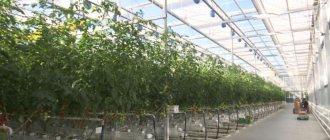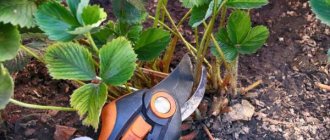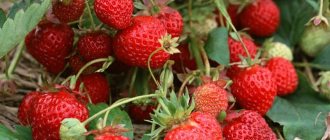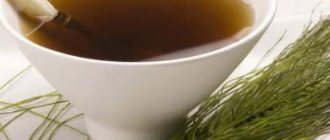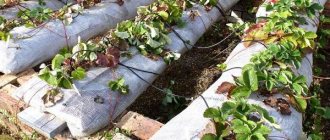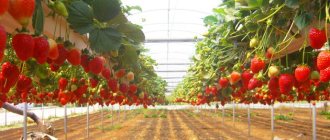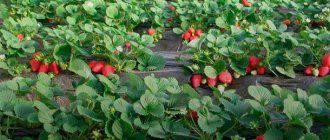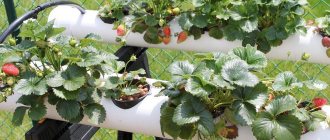The Dutch have proposed an interesting method for growing strawberry bushes to harvest year-round berries. Every year it is gaining momentum due to its effectiveness and relative simplicity. Anyone can try out the Dutch method of growing strawberries in action, even on an apartment windowsill.
Arrangement of the premises
The culture needs a warm greenhouse, protected from drafts. A polycarbonate structure (or glass, thick film, cellular plastic) is ideal - arched or with a pitched roof. A pair of windows are required for regular ventilation of the room.
A finished design with these parameters costs about $1,100. You can purchase only the frame ($120-150) and tighten it yourself with a thick film, leaving space for windows and doors. In this case, the cost will be $700-800.
To provide sufficient lighting, the greenhouse is equipped with fluorescent or LED lamps (about 10-15 pieces).
Common options: stove, gas, electric water heater (pipes under the beds with hot water).
A multi-level system for arranging beds helps to save space and increase the amount of harvested crops.
In total, it costs about $2,000 to set up a greenhouse.
How to harvest seedlings
Recommended strawberry varieties are Fort Laremy, Sakhalinskaya, Inexhaustible, Primadonna and others. In order to properly grow the crop, the selection of mother bushes occurs in early summer, when the first ripening begins.
Bushes rich in harvest are remembered or marked in any convenient way; after the appearance of young shoots, those that are too long are cut off, leaving no more than five rosettes. Until the second ten days of August, the resulting seedlings do not need to be touched. This will give them the opportunity to take root well, grow stronger and gain strength.
Year-round cultivation of berry crops can be done by planting from seeds. But at the same time, the planting material must be of different quality and be hardened. This way you can harvest a good and high-quality harvest all year round, even in winter.
The technology of growing seedlings from seeds in a greenhouse practically does not interfere with the agricultural technology of growing on the site. The difference is in the timing of disembarkation.
Stages of growing strawberries using Dutch technology
In the greenhouse, it is necessary to create conditions that fully meet the requirements of the plant, and also to take a responsible approach to choosing a promising variety and harvesting high-quality seedlings.
Suitable strawberry varieties
Greenhouse cultivation of strawberries using Dutch technology excludes natural pollination. To avoid having to manually shake pollen off the inflorescences, you need to plant self-pollinating varieties. Remontant hybrids produce good yields.
Among the most promising varieties and hybrids of strawberries for the Dutch growing method are: Maria, Lord, Honey, Red Rich, Selva, Tristar, Vima Zanta, Corona.
Preparation of planting material
Strawberry seedlings for Dutch cultivation can be purchased from agricultural companies or prepared independently. Young seedlings for Dutch beds are dug out from open ground in September. All large leaves are cut off from the seedlings, leaving only the rosette. The roots of the bushes are not washed or shortened; it is enough to lightly shake off the soil.
The seedlings are sorted and stored in the refrigerator. The technology for freezing seedlings is called Frigo. Before planting, the bushes need to be “awakened” by keeping them at room temperature for at least a day.
Preparing the soil mixture
According to the Dutch method, strawberry seedlings are planted in a soil mixture of peat and perlite in a ratio of 2 to 1. You can also mix turf soil and coarse river sand in a ratio of 2 to 1 and add one part of moisture-absorbing lowland peat. Before planting, the prepared soil must be disinfected (calcined at high temperature).
Some gardeners practice growing strawberries using Dutch technology on an artificial substrate: coconut fiber, expanded clay, mineral wool. This approach requires accurate calculation of the proportions of mineral additives in the nutrient solution and the organization of a system for continuously supplying them to the strawberry roots.
Do not fill containers with garden soil, or add manure or other organic matter to the soil. In such soil there remains a high risk of strawberry infection with diseases, pest invasion and weed germination.
Rules for planting strawberries in Dutch beds
You can plant seedlings in any container: flower pots, plastic containers, synthetic bags. In the future, they can be sterilized and reused. Metal containers cannot be used for planting strawberries.
The planting technology is no different from planting seedlings in open ground. When placing containers horizontally, the step between bushes is 25-30 cm. In a vertical position, strawberries are planted in a checkerboard pattern, reducing the distance between bushes to 10-15 cm.
Reviews from gardeners about the method
Alexander P. He grew strawberries for sale in open ground for many years. It is a labor-intensive process, and the harvest directly depends on the weather. A couple of years ago, a neighbor boasted that he was mastering a new method - growing strawberries using Dutch technology. I’ve been practicing this method for a year now, but I had to work hard at first because I learned from my mistakes. For example, I made a drip irrigation system myself. As it turned out later, it was better and cheaper to buy in a store.
Inna Zh. In my greenhouse, strawberry bushes are planted in bags. For a small area, processing and feeding them is quite simple. But I think that on an industrial scale this is inconvenient.
Mikhail D. I have been growing strawberries using this method for several years. We haven't come up with a better way yet. The berries are as sweet and large as in a good, well-kept garden bed. One tip: be sure to ventilate the greenhouse, especially in the warm season. This way the plants bear fruit better.
Dutch strawberries in containers - where to plant seedlings and where to get them
The Dutch method of planting and growing strawberries involves the use of ceramic pots, which are placed on a metal frame in several steps in a greenhouse. But if you just imagine for a moment how much such a number of flower pots will cost, then not everyone will want to grow strawberries. What to do? Farmers will not be paying subsidies like in Europe any time soon, at least not in this century, and there is no opportunity to spend several thousand euros on containers. Dead end?
In fact, everything is much simpler; the Russians have significantly simplified the abstruse designs and replaced expensive ceramics with plastic bags. 2-3 bushes will grow in such a bag, it costs no more than 8 rubles, and even cheaper on the wholesale market. By spending only 300-400 rubles, you can equip the entire greenhouse and grow up to 1000 strawberry bushes. To make the “correct” pot, we need to perform the following steps:
- Place future soil for strawberries in a plastic bag, namely: 4 parts fertile soil, 1 part peat, 1 part sand, 1 part humus (manure), 1 part clay. Mix it all thoroughly, then tie the bag tightly. Do this with all the “pots”.
- Place the bag on a metal structure (if there will be hanging strawberries) or simply on the floor, cut 2 holes with a diameter of 10 cm. Seedlings will be planted there.
- Secure the polyethylene with plastic tapes, ropes or other available materials so that it does not fall.
The appearance of the “pots” will not be very presentable, but they can be replaced as funds become available with ceramic and plastic products. The Dutch method of planting and growing strawberries has one drawback - it is necessary that the greenhouse transmit light not only from above, but also from the sides, since when grown vertically, the plants below will not receive enough light.
Absolutely any seedlings are suitable for growing berries in this way; you can plant early strawberries or late ripening ones - there is no difference! Of course, it will be better to choose the most disease-resistant variety, but, as a rule, with proper care there is nothing to fear. You can simply buy seedlings at any agricultural company or flower shop. If this is the case in winter, then you will have to go to a wholesale center where frozen seedlings are sold - a special type of supply of plants in which they are stored in freezers at subzero temperatures.
The risk of purchasing “killed” seedlings is very high, but here you need to decide what you want more, take a risk and grow strawberries in December or wait until mid-spring to buy seedlings. If you are lucky and buy high-quality seedlings, then after 2 months you will be able to plant bushes from the first shoot, and you will have your own nursery.
Cassette seedlings
Gardeners consider the second method more preferable, and it is called cassette seedlings . In this case, young tendrils are taken from the mother plants and cooled at zero temperature and a humidity level of 95% for an hour. It takes no more than 6 weeks to obtain seedlings from cassettes. The resulting seedlings have an extensive root system, which serves as a reliable support for the above-ground part of the plant.
After this, the cooled sockets are placed in the cells of containers with a nutrient substrate with a total volume of at least 150 cubic cm. By the end of the third day, the length of the roots increases to 4 cm, and after 7-10 days the basic root system is formed. Take care of the seedlings in the first month and do not expose them to sunlight. After the fifth week, the plant can be moved to a sunny place.
If you plan to grow strawberries throughout the year, then you need to purchase self-pollinating varieties: Corona , Marmolada , Kimberly , Honey , Florence , etc. Otherwise, you will have to pollinate the plants yourself.
Varieties
An important aspect in organizing a strawberry business is the choice of variety. This is also not such a simple matter.
To begin with, it is worth informing that strawberries for growing in a greenhouse are usually chosen:
- self-pollinating, which does not require pollinating insects;
- remontant, which is capable of blooming several times per season and bears fruit constantly.
Remontant strawberry
Table. Strawberry varieties for growing in a greenhouse.
| Name, photo | Description |
| Queen Elizabeth 2 | It bears fruit with very large and beautiful, quite dense and juicy berries, which can weigh 50 g, and sometimes even 125 g. The variety has a high yield - from one bush you can collect up to 5 kg of sweet berries per season. The disadvantage is the need to annually renew the bushes to avoid crushing the crop. |
| Temptation F1 | Produces smaller (up to 40 g) berries with a unique taste. Sufficiently dense and juicy fruits appear very quickly - just 1.5 months after planting the seedlings in the soil, you can harvest the first harvest. From one bush you can collect up to 1.5 kg of berries. |
| Albion | It produces small, but very tasty and aromatic berries. High-yielding variety (2 kg per bush). It begins to bloom immediately after rooting and therefore bears fruit early. Forms few whiskers. |
| Lyubava | It produces small, but very tasty and aromatic berries. High-yielding variety (2 kg per bush). It begins to bloom immediately after rooting and therefore bears fruit early. Forms few whiskers. |
| Ruyana | A variety that does not form a mustache and actively bears fruit. It produces aromatic and sweet berries weighing about 40 g. By the way, these are not even strawberries, but wild strawberries. |
When choosing a variety, be sure to think about what conditions a particular species needs for normal development and growth, as well as fruiting. For the strawberry business, the best ones are those that do not react strongly to changes in daylight hours, constantly bloom and bear fruit abundantly, and produce very tasty and aromatic berries.
It is recommended to grow strawberries with high fruiting and constant flowering for sale.
Garter bushes
Most likely, you have already seen how strawberries are grown in Holland - these are complex metal frames with tensioned wires every 20 centimeters, to which the bushes are tied. Thus, they intertwine, creating a uniform green wall, on which many fruits are subsequently formed.
If you are going to grow tall strawberry bushes (called "strawberry trees"), then you will need some wire. It must be pulled horizontally. This should be done every 20 centimeters above the bush and up to 150 cm in height (depending on the variety you choose). But it will be more practical to grow ordinary varieties of strawberries, since they are much easier to care for and harvest, and the yield of such varieties is 30-40% higher than that of climbing plants.
Technology of horizontal cultivation of strawberries in plastic bags
The least expensive technology for growing strawberries involves the use of translucent plastic bags (made of white polyethylene). The standard thickness of such bags is 0.2 mm. Dimensions - 16x20 cm. You can buy bags at any household goods store.
Growing strawberries in bags horizontally
You will also need the following components to prepare the substrate:
- peat (2 parts);
- perlite (1 part);
- sawdust (1.5 parts).
This technology for growing strawberries allows you to start a business with the smallest amount of capital - from 3 to 5 thousand rubles. This will be enough to plant seedlings on an area of 10 m2. From 1 m2 you can get from 15 to 20 kg of berries. When you gain experience in growing strawberries, the harvest volumes will increase. Specialists receive up to 50 kg/m2. The business can be considered economically profitable with a yield of 150 kg per 10 m2.
Lying bags - an alternative to raised beds
Sequencing
Step 1. Substrate preparation: mix sawdust, perlite and peat in a ratio of 1.5:1:2.
The main properties of perlite are loosening the soil and improving its structure.
Step 2. Fill plastic bags with substrate to ¾ of their volume.
Step 3. Seal the top of the bag using an iron or soldering iron.
Step 4. Using any sharp object, cut 2-3 longitudinal holes 7-9 cm long in each bag.
Step 5. Place bags with substrate in even rows on the flooring or floor so that there is at least 25 and no more than 30 cm between the “beds”.
Step 6. 3 dropper tubes are connected to each bag. One tube is immersed on the bottom layer of the substrate, the second on the middle, and the third on the top. Water consumption – 0.5 l/day per 1 package.
Dripper connection diagram Approximate diagram of a drip irrigation system
Step 7. Seedlings are planted in each slot in the bag.
Step 8. Provide optimal conditions throughout the entire period of plant growth and fruiting.
At the initial stage of strawberry growth (in the first week after planting the seedlings), it is necessary to maintain a temperature of +10°C in the greenhouse. Then the indicator is gradually raised to +20°C. During the flowering period, the optimal temperature is from +20 to +24°C.
An important microclimate parameter is humidity. It must be maintained within 80%, but during the flowering period it must be reduced by 5-10%. When the fruits begin to form, another decrease in humidity by 5-10% will be required.
Growing strawberries in bags
Rules for growing strawberries
Throughout the growth, flowering and fruiting of plants, it is necessary to ensure high-quality ventilation of the greenhouse. Every 14-15 days, starting from the day of planting the seedlings, fertilizers are applied - superphosphate and potassium salt. For strawberries, the quality of lighting is extremely important. This plant is warm and light-loving
If the daylight hours last at least 16 hours, the berries will form already on the 35th day after planting the seedlings. If the period of full illumination does not exceed 8 hours, the waiting period for the harvest will be longer (up to 1.5 months). Therefore, if there is not enough sunny days, it is recommended to arrange artificial lighting for the greenhouse. If the chosen variety is not self-pollinating, it will be necessary to carry out artificial pollination using a small and soft paint brush.
A possible option is a device for growing strawberries Topsy Turvy Strawberry Planter Strawberry Planter for growing strawberries
A little history
Fragrant, juicy, tasty strawberries rightfully bear the title of queen of berries. Strawberries are one of nature’s most amazing creations, a real storehouse of healthy vitamins. It can protect the body from flu, strengthen the immune system and relieve insomnia. Moreover, in addition, it can have a very strong anti-inflammatory effect.
In an unheated film greenhouse, strawberries can produce a harvest 1.5-2 times faster than in open ground.
According to legend, one day a French traveler found amazing red berries high in the Chilean Andes. He liked their taste so much that, among other curiosities, he brought home a whole bag of aromatic sweet berries and several plants. So strawberries, under the name of garden strawberries, came to the table of the French kings, who valued them almost on a par with gold. According to another legend, at the beginning of the 18th century, a Russian merchant bought several strawberry bushes, paying a chest of gold for them.
And although strawberries, as befits a queen, are quite picky, nevertheless, every self-respecting summer resident, not to mention rural residents, considers it his duty to plant at least a small bed of them on his plot. But, dreaming of a good harvest, he rarely gets it: either spring frosts will damage the color, or a dry May will not allow the berries to grow large and juicy, or during ripening, heavy rains lead to the fact that most of the harvest will be lost.
Of course, during the “strawberry” season it is not a problem to buy strawberries in a store or at a market. But is it possible to be sure that the healing properties of the purchased berry correspond to its commercial appearance? Gross violation of agricultural cultivation techniques, the use of chemical fertilizers and growth stimulants, and if we talk about the products of greenhouse plants, then the complete replacement of sunlight with artificial light does its dirty deed, turning a healing berry into a poisonous one.
How to grow strawberries using the Dutch method?
You can get the first berries at the beginning of winter if you plant seedlings at the end of summer, in August. Rosettes are planted in plastic bags filled with substrate or in various plastic containers, the depth of which is at least 25-30 cm.
Figure 2. Bags of strawberries should be placed on one or two tiers, not forgetting about abundant lighting.
- You can make bags for growing strawberries yourself. To do this, a rectangle 51 cm wide is cut out of dense polyethylene; its length will depend on the wishes of the owner. The film is folded in half lengthwise, sealed or the side seam is sewn. The result is a sleeve with a diameter of approximately 16 cm. A specially prepared mixture is poured inside the bag.
- The substrate mixture consists of steamed peat mixed with perlite in a 2:1 ratio. The peculiarity of this material is that it can absorb moisture in amounts up to 400% of its volume, gradually releasing it if necessary. This ensures an even supply of moisture to the roots.
- To plant strawberry rosettes in the bag, cut holes in 2 rows:
- at a distance of 25 cm from each other, if the holes in adjacent rows are staggered;
- at a distance of 40 cm if they are located in pairs.
Remove excess leaves from strawberry bushes, leaving 3 leaves. The root is pinched a little and the rosette is placed in the cut hole so that its central part, the “heart” or growing point, is located at soil level. Rice. 1.
The bags are placed on the greenhouse racks so that there is a distance of at least 50 cm between them. The height of the rack should correspond to the height of the person caring for the strawberries. Bags of seedlings can be placed in 1-2 tiers, not forgetting to provide enough light for each bush. Rice. 2.
The Dutch method of growing strawberries involves placing bags of seedlings in both horizontal and vertical positions. When the bags are arranged vertically, space for their placement is significantly saved. You can also plant plants vertically on the side of the sleeve that is at the bottom when positioned horizontally, but the natural lighting conditions for the plants will not be the same. Therefore, it is necessary to provide for the possibility of artificial illumination with fluorescent lamps or to rotate the vertical bag several times a day so that the sun illuminates all its sides.
Figure 3. Options for placing vertical strawberry plantings.
You can use plastic or metal pipes with a diameter of 16-20 cm. The pipe is prepared as follows:
- Holes with a diameter of 5-7 cm are cut out in opposite sides; each next row of holes is placed in a perpendicular direction to the previous one. The distance between rows is 25 cm. Fig. 3;
- the pipe is filled with soil, and a rosette of strawberries is planted in each hole. To prevent soil from spilling out of the holes, you can place a bent disk of plastic or tin into their lower part, forming a platform located at an angle of 45 °;
- the pipe is installed and securely fixed in a vertical position.
Each 2 m long pipe can accommodate about 20 plants, which, with good care, will yield a harvest of 5-8 kg of marketable berries.
Choosing a greenhouse
If you decide to grow strawberries, then the question of choosing the type of greenhouse will be one of the first. In terms of strength, polycarbonate buildings are considered the strongest. You can buy a ready-made version, or you can make the design yourself. To do this, you will have to purchase all the necessary materials and equipment yourself.
The following types of greenhouses are more suitable for planting remontant strawberries:
- greenhouse - a house, the growing conditions in which are practically no different from ground ones;
- a mini-greenhouse, which consists of several levels; it can be easily built from a regular rack by placing boxes with substrate on it;
- vertical greenhouse made of large-diameter polycarbonate pipes, the height of the structure should not be more than 120 cm.
The quality of the future harvest and the technology for growing the crop depend on what type of greenhouse was chosen.
It is also important whether the future greenhouse is heated or not.
Preventative treatment
Methods for preventing diseases and pests:
- Regular ventilation.
- Avoiding waterlogging of soil and air.
- Maintaining distances between neighboring bushes.
- Compliance with fertilizer standards. It is especially harmful to exceed the norms of nitrogen fertilizers.
- Preventive treatment with fungicides - they are introduced along with water through a drip irrigation system.
- Only healthy seedlings are planted.
- Timely removal of diseased, dried or broken stems and leaves.
- Destruction of diseased bushes.
- Before the formation of ovaries, strawberries are sprayed with Fitosporin, Alirin or Glyokladin - for prevention.
Main advantages and disadvantages
The number of gardeners who practice this method of cultivation is increasing. The reason for this is the advantageous features of the technology:
- You can place a large number of berry bushes using the minimum size of planting areas.
- In heated greenhouses with many transparent walls, natural light will be sufficient.
- Any premises can be used for planting.
- Strawberries do not come into contact with the soil, therefore they are not exposed to diseases and pests as much as possible.
- The high probability of obtaining a stable harvest in 1-2 months is the main reason for the popularity of the Dutch method of growing strawberries among businessmen and farmers.
- The installed system has been in operation for many years.
- The taste of strawberries is in no way inferior to berries that were grown using traditional technology.
There are also a number of difficulties when using this technique. These include:
- The need for constant provision of planting material. Seedlings need to be supplied all year round. It is best for small farms to grow it themselves, but for large-scale greenhouses it is easier to purchase it.
- Constantly maintaining optimal lighting conditions and temperature inside the premises used. It is necessary to artificially extend daylight hours.
Planting methods
According to the method of growing strawberries proposed by the Dutch, both the horizontal method of placing bushes during planting and the vertical arrangement are equally good. The alternative is determined by the area of the room and its equipment with an additional lighting system.
Horizontal
With this method of arranging seedlings, they are planted in a single line, placing containers in rows parallel to the floor surface. This planting method is applicable for large volumes and areas. Considered less expensive. Can be used in conjunction with the vertical method of placing strawberry bushes.
Watch a video about the horizontal method of planting strawberry seedlings:
Vertical
Vertical landing is located at right angles to the floor. Cascading planting, in compliance with a checkerboard pattern, allows plants not to come into contact with each other as they grow. Therefore, maintain a gap of at least 25 cm between strawberry bushes. Use PVC pipes, bags, boxes and other containers. The method has found application in small farms and among gardeners.
The vertical method of planting strawberries is presented in the video below:
Growing strawberries at home
Using Dutch technology for growing strawberries at home is not much different from the greenhouse method. Only the bushes should be placed in a horizontal plane to ensure proper lighting. You will also have to work hard to create optimal temperature and humidity levels.
This method of growing strawberries, when properly organized, gives a stunning harvest. Just keep in mind that such strawberries will never get the taste and aroma that berries from open ground have.
If all the necessary conditions are provided, flowering will begin on the 10-14th day, and after 30-40 days the bushes will begin to bear fruit.
- Air temperature: around 20... 25 degrees. Before flowering, this indicator can be 18... 21 degrees, when flowers appear - from 23 degrees. Avoid temperature changes;
- Air humidity: during planting – 80-85%, during growth and flowering – 70-75%. You can maintain the desired level of humidity by spraying the bushes, but during flowering you should avoid this. If liquid gets on flowers or fruits, it can lead to diseases;
- Length of daylight: 15-17 hours a day. Artificially increasing daylight hours using fluorescent lamps accelerates plant growth;
- Ventilate the greenhouse daily for 20-30 minutes.
In the first month, the bushes are watered daily, then once every 5-6 days. The peculiarity of watering is that water should not fall on a flowering or fruiting bush, but should go directly to the roots of the plants.
You can connect a separate tube coming from a large bottle of water to each box/pot, or connect them and lower the ends into a reservoir of liquid.
Top dressing
Every one and a half to two weeks, the beds should be fertilized with mineral-containing compounds. Special liquid fertilizers containing nitrogen, phosphorus, potassium, and magnesium are suitable.
How to care for plants so as not to lose the harvest? During the flowering period, berry bushes should be treated with fungicides once or twice to protect against diseases.
In such conditions, a strawberry growing business promises to be profitable and bring a stable income to a company or individual entrepreneur. There is a real chance to occupy an empty niche and gain a strong foothold in it.
One of the features of the plant is its unpretentiousness - it feels excellent both in open ground and in a greenhouse. Both methods of growing strawberries are successfully used in our country, and the technology has been thoroughly developed.
In the first option, the costs are minimal, but the yield is highly dependent on external factors. Cultivating berries in greenhouses guarantees high results, but also requires significant initial investment.
Any agricultural production begins with solving the land issue. To grow berries in commercial quantities, you will need a large plot of land.
Of great importance when organizing this type of business is such factors as the composition of the soil and the availability of a water source for organizing sufficient and regular watering.
To organize the process of growing strawberries, you will need equipment and materials:
- seedlings or seeds;
- fertilizers and plant protection products against pests;
- agricultural implements;
- irrigation equipment.
Tilling the soil, planting and caring for them, as well as harvesting from fairly large areas, will require the involvement of a certain number of workers. It is necessary to provide places for workers to rest and eat, as well as facilities for storing inventory and equipment.
Practice shows that in the summer, most of our fellow citizens prefer to purchase berries for food and canning at markets. In winter, frozen strawberries are mainly sold in supermarkets.
https://www.youtube.com/watch?v=3sMwki2PpbA
It is necessary to agree in advance with representatives of retail chains, shops or supermarkets about the supply of your products.
Caring for strawberry bushes
Caring for strawberry bushes in closed conditions plays an important role. To do this, follow these steps:
- Don't forget about watering. It should be moderate. You can make a drip moisture distribution system yourself or purchase it in specialized stores.
- Regulate the length of daylight hours with additional lighting. To remember this, the system can be automated using timers.
- Keep the temperature in the greenhouse from 18 to 25 degrees. During the strawberry flowering period, reduce the temperature to 21 ° C.
- Monitor the temperature when preparing and storing seedlings. At -3 degrees the plants die, and at +3 degrees the seedlings wake up.
- Maintain humidity levels, ventilate the room and spray the plants.
- Go through the plants, removing dry leaves and unusable fruits.
- Keep an eye on pollination.
- Replace bushes that have finished bearing fruit in a timely manner with new ones. Rooted tendrils from “old” strawberries can be used as seedlings.
Growing strawberries in a greenhouse as a business
Strawberries are one of the most delicious berries, always in demand among consumers. The strawberry business quickly pays off and brings good income. True, you have to work for this - the berry crop requires care.
Expenses
When starting a strawberry greenhouse business, you need to calculate the initial costs - you will need a certain amount of capital.
Approximate calculation of land costs:
- the cost of the land plot is 500,000 rubles;
- construction of polycarbonate greenhouses – 500,000 rubles;
- purchase of seedlings - about 180,000 rubles (based on 3 greenhouses, each of which has 1,200 bushes planted at a cost of 50 rubles per piece);
- business registration – 20,000 rubles.
If you have your own plot of land - 1 hectare in size, then you will need 500,000-750,000 less money.
Also, the cost of strawberries includes current expenses. You will have to pay annually for:
- electricity and heating – 25,000 rubles;
- fertilizers, preparations for prevention – 5,000 rubles.
- other costs - 10,000 rubles.
You should also consider the cost of purchasing planting material. If you don’t grow seedlings on your own, you’ll have to buy them all the time.
Sales of products
Selling strawberries is one of the most important stages. Strawberries are a delicate berry; even the most shelf-stable varieties do not last long. You cannot delay the sale - the harvested crop must be sold as quickly as possible. Therefore, sales must be agreed upon in advance.
Sales options:
- Serve in stores, supermarkets, and other retail outlets.
- Hand over to processing plants.
- Sell to restaurants, cafes, etc.
- Organize your own strawberry sales points.
- Delivering strawberries to your home - this option is only suitable for a metropolis.
When and what kind of profit can I expect?
If you choose the right variety, you can harvest up to six harvests in a year. The price per 1 kg depends on the time of year. Let's calculate the approximate profit based on previously accepted conditions - there are three greenhouses.
Estimated income:
- In spring and summer, 1 kg of berries costs 100 rubles. If one greenhouse produces 360 kg, then from three greenhouses you can get more than 100,000 rubles.
- In autumn and winter, the price of berries is three times higher - 270-300 rubles per 1 kg. Accordingly, income increases to 270,000 rubles.
As you can see, growing strawberries in greenhouses can bring enormous profits, and all investments pay off in a maximum of 2 years.
Strawberries are a popular berry and you can make good money selling them. True, you will have to fulfill several conditions - invest a large sum in business development, find markets, select a successful variety, and properly organize the process of greenhouse cultivation and care.
Preparing and fertilizing the land
And so, the place for planting the strawberries has been chosen - this is a polycarbonate greenhouse. Next, what about the ground? To plant strawberries, it is best to choose soil in which cereals have previously sprouted. You can bring this land from the fields. It is not advisable to plant strawberries in soil that previously contained potatoes or cabbage. Cultivation in greenhouses can be done using turf soil. It can be loosened using sawdust.
The periodic addition of bait is considered very important during the germination of bushes, their formation and the appearance of berries. This crop requires organic and mineral supplements. Gardeners, as a rule, use peat, compost and manure as organic fertilizer. To make your task easier, you can use complex baits containing organomineral substances.
In order for cultivation to take place effectively, it is necessary to buy healthy and high-quality raw materials for planting. Those who have a couple of ridges of this berry can choose strong seedlings from the mother bushes for this planting.
Features of cultivation
To avoid mistakes and get results all year round, you need to take into account the specifics of using this advanced technology.
Plants need stable temperatures. To grow and produce strawberries in cold weather and in winter, the room is heated.
The greenhouse requires regular ventilation and airing.
Strawberries need to be illuminated with phytolamps that provide intense light similar to sunlight. They are placed at a height of 1 m above boxes or shelves. Lighting efficiency is enhanced by reflective materials.
The length of the day is increased to 12-16 hours. This is how they achieve the start of fruiting on the 30-35th day.
The greenhouse is equipped with a drip irrigation system that supplies water to each seedling. It prevents moisture from entering the vegetative parts of the bushes and helps avoid infection with fungal infections. Irrigation combined with fertilizing provides strawberries with complete nutrition.
If the nuances of cultivation are ignored, there is a risk of losing part of the harvest.
Artificial lighting
As for light, you need a lot of it. The plant needs to be provided with a 14-hour working day so that all processes occur correctly and a lot of chlorophyll is produced. If the exchange of organic substances and minerals in the stem is carried out properly, strawberries will quickly gain vegetative mass.
Dutch strawberry varieties, as a rule, have low and voluminous bushes to make working with them as convenient as possible in limited space. The lighting element is installed directly above the bush, no more than 60-70 centimeters. Please note that it is not recommended to use lighting devices that emit a lot of heat (for example, a diode or an incandescent lamp) - you can burn the leaves.
According to agricultural requirements, it is necessary to provide light with a power of at least 400 lumens for each bush, which is equal to the light power from an 80 W diode lamp (at a distance of 1 meter). It is not recommended to increase or decrease daylight hours; it is better to constantly maintain it around 14 hours and not change the temperature - plants bear fruit better under stable growing conditions.
Suitable varieties for growing
To produce strawberries using the Dutch farmers’ method, you need to choose the right varieties. Remontant ones are especially suitable. Their advantage is the ability to self-pollinate. If insects are used to pollinate flower stalks, beehives are placed in large rooms. Artificial wind created by fans is suitable for this purpose.
The following varieties are preferred:
- Darselect. An early ripening variety from France with orange-red-brown heart-shaped berries. Has average winter hardiness. From each bush you can harvest up to 1 kg of crop.
- Marmalade. Two waves of comb-shaped, bright red berries native to Italy. Productivity up to 900 g of berries per bush.
- Polka. The conical berries are deep red in color. Up to 1 kg of large berries is harvested from each strawberry bush.
- Selva. Super-yielding variety from America. The weight of fruits per bush is about 1.5 kg.
- Sonata. Variety from Holland. The berries are large, bright, mid-ripening. Withstands light frosts. The yield is up to 1.5 kg of berries per bush.
- Tristar. Strawberries crossed with Milanese strawberries produce high yields of large red berries. Frost-resistant.
variety “Darselect”
“Marmalade” variety
“Polka” variety
variety “Selva”
variety “Sonata”
variety “Tristar”
The essence of the methodology and features of the technology
The name of the method indicates that it was invented in Holland. Using this technology, a certain microclimate is maintained in the greenhouse (greenhouse), which allows minimizing the loss of berries. Strawberry seedlings can be planted at any time of the year.
Important! The main difference from the traditional method is that immediately after one fruiting period the next begins. This creates a continuous harvest cycle.
To ensure this effect, seedlings are planted constantly. To grow all-season strawberries, you will need special equipment. The choice of variety should be focused on remontant varieties. The first plants can be purchased in specialized stores, and then you can grow your own from the mustache. Some owners grow seedlings from seeds of their favorite variety.
Another important feature is the lack of contact of fruits with soil. That is why they do not deteriorate or rot. Many people plant strawberries vertically. This helps to save space and get the maximum possible profits from a minimum area.
Preference is given to the following varieties of strawberries:
- Darselect . French variety, bred in 1998. Refers to early ripening, having a short period between flowering and ripening of berries. The shape of the fruit is heart-shaped, bright brick color, average winter hardiness. Productivity from 1 bush to 1 kg of berries.
- Marmalade . Italian variety of medium ripening, bred in 1989. With early first fruiting, the second wave quickly occurs. The fruits are large, comb-shaped, bright in color. Productivity from 1 bush is up to 0.9 kg of berries.
- Polka . Bred by Dutch breeders in 1977. It has large glossy, bright red conical-shaped fruits. It bears fruit for a long time. One bush yields up to 1 kg.
- Selva. An American variety that appeared in 1983. The plant has large dark red fruits and is frost resistant. Productivity from 1 bush is up to 1.5 kg.
- Maria. Super early strawberries with large bright red berries. The rosettes are resistant to fungal diseases and minor frosts. Productivity from 1 bush to 1 kg of berries.
- Sonata. The Dutch variety, bred in 1998, is medium-fruited, with large, bright red fruits and high frost resistance. Productivity from 1 bush is up to 1.5 kg of berries.
- Tristar . A compact, powerful plant with large fruits, bred by crossing wild strawberries and Milanese strawberries. It has large, conical berries. The sockets are resistant to any changes in temperature and humidity. Productivity from 1 bush is up to 1.5 kg.
The varieties Baron, Gloom, Tribute, Albion, Elizabeth 2, and Fresco are no less attractive to gardeners. With proper care and proper selection of planting material, from 1 square meter of greenhouse you can get up to 50 kg of strawberries during the fruiting period.
The choice of the optimal variety for constant production of berries should be based on its ability to produce the maximum amount of yield in any soil and climatic conditions. In addition, you need to remember that strawberries are a flowering and pollinated plant, and in a closed greenhouse this is extreme. Therefore, varieties need to be chosen that are self-pollinating.
Step-by-step instructions for growing strawberries using Dutch technology
After a strawberry variety has been selected, planting material, a greenhouse and all equipment have been prepared, you can begin planting strawberries using Dutch technology. If we fully comply with the original source, then in Holland plastic pipes with holes, each up to 2 meters long, are used for plants. They are filled with a special mixture (substrate), and drip irrigation is carried out inside. Holes are cut in the upper part of the pipes into which plant bushes are planted.
In any case, each gardener independently decides which containers to use for work
However, special attention is paid to the quality of the soil mixture. It is based on sterile soil, perlite, mineral or coconut fibers and always peat
Important! You can buy sterile soil in specialized stores or make it yourself. To do this, it is enough to calcine or freeze the soil, eliminating harmful bacteria and fungi from it. The containers are filled with soil and after this planting is possible
A depression is made in the soil and a rosette is planted so that it is flush with the surface of the soil (or bag). The distance between the bushes is from 25 to 30 cm. Strawberries are planted vertically in bags at an angle of 40 degrees at a distance of 20-25 cm from each other (preferably in a checkerboard pattern)
The containers are filled with soil and after that the plants can be planted. A depression is made in the soil and a rosette is planted so that it is flush with the surface of the soil (or bag). The distance between the bushes is from 25 to 30 cm. Strawberries are planted vertically in bags at an angle of 40 degrees at a distance of 20-25 cm from each other (preferably in a checkerboard pattern).
Next comes long and painstaking care for each plant so that it produces a bountiful harvest.
- Watering should be done regularly. In this case, water should not get on the leaves or berries. The good thing about the Dutch method is that it involves drip (regulated) irrigation. You can make a watering system yourself.
- To increase the length of daylight, you need to turn on the lamps 2 hours before sunrise and for the necessary time until it reaches 12-16 hours. To avoid doing this yourself, you can equip the system with lighting timers.
- It is necessary to carefully monitor the temperature. For this purpose, special thermometers and sensors have also been developed to signal a violation. When growing strawberry bushes, the temperature should remain from 18 to 22 degrees Celsius, during the growing season from 26 to 28 degrees Celsius.
- To prevent fungus from developing, the greenhouse must be regularly ventilated.
- A normal level of humidity can be maintained if the plants are regularly sprayed with spray bottles and containers of water are placed in the corners of the greenhouse.
- If you have chosen strawberry varieties without self-pollination, you must carry out this procedure yourself (with a brush) or with the help of a fan during the flowering period.
- At intervals of 2 months, old bushes are dug up and replaced with new planting material. Thus, the harvest is harvested all year round.
If all conditions are met, flowering is observed 10 days after planting the bushes, and after another 35-37 days active and vigorous fruiting is observed. After harvesting, the strawberry bushes are removed, the largest and most powerful of them are left for new seedlings.
Necessary materials and equipment
To implement the Dutch method of growing strawberries, you cannot do without:
- Containers for planting strawberry bushes. The choice of containers is great, here you can rely on your imagination. Flower pots, empty PET containers, bags or propylene pipes with slots, old car tires with holes for seedlings, and much more are suitable. The main condition is to place them so that the plants have enough light.
- Seedling. It is preserved using a mustache or cassette method.
- Priming. Regular soil from the garden will not work. It is worth preparing or purchasing special soil.
- Organization of watering. A point irrigation system and humidifiers are used to ensure optimal humidity in the greenhouse.
- Lighting system. Responsibility and attention when choosing and proper placement of additional lighting fixtures is the main component for obtaining a harvest. Energy-saving and LED lamps or special phytolamps of red-blue radiation are used.
The process of growing strawberries in Dutch
The method, like any other growing process, includes several stages. To establish the process of growing strawberries in a greenhouse using Dutch technology, you need to do the following:
- Select a variety for cultivation.
- Prepare the seedlings.
- Start arranging the planting soil.
- Provide care for bushes using high-quality drip irrigation.
Preparing seedlings
Seedlings are constantly needed, because they are changed every two months. Seedlings can be grown or purchased in specialized stores. When deciding to cultivate seedlings yourself, you should follow the step-by-step instructions. It consists of the following stages:
- Peduncles with tendrils are cut from the mother bushes; next year there will be from 16 to 19 shoots, which need to be rooted.
- After the previous procedure, the crops are allowed to develop; in the fall they are dug up, placed in a cool place, and stored, ensuring natural dormancy and maintaining the temperature regime (-2°C).
- If necessary, seedlings are removed from storage, placed in a warm place for 24 hours, and then planted in containers filled with specially prepared soil or mineral wool or coconut fiber.
- The bushes are watered using the drip method.
- Subsequently, they are grown taking into account agrotechnical requirements.
The soil for planting mother bushes is prepared in October by adding organic fertilizers, lime, superphosphate, and potassium chloride. In the spring, plants are planted in such a soil mixture, making 40 cm between rows. For containers, the optimal soil is considered to be:
- peat;
- coconut fiber;
- perlite
Seedlings are planted in filled containers with soil according to a checkerboard pattern (25 by 30 cm). It is better not to reduce the distance so that the crops do not lack nutrients; this scheme also reduces the likelihood of obtaining very small berries.
Small plastic bags (up to 16 cm) are considered good planting containers. They are filled with soil, making a distance of 25 cm, holes are cut in them, where the bushes are planted with a slope of 40 degrees. The option of such plantings is very practical, since the bags can be hung in several rows even on balconies, thereby increasing the yield.
A substrate made from a natural soil mixture and synthetic components is ideal. When growing at home, it is not recommended to use a mixture of sandstone with old manure to prevent the development of diseases and the appearance of parasites.
How to obtain planting material
Several methods have been developed for obtaining good strawberry planting material. But the most commonly used are 2 of them:
- Usami. Mother plants growing in the ground before the onset of cold weather produce mustaches. They are carefully dug up, the leaves are cut off and placed in a dry, dark, well-ventilated room. Their storage temperature should be no higher than 2 and no lower than 0 degrees Celsius. A day before planting in the ground, the rhizomes are transferred to a room at room temperature. After this, the whiskers are sorted and the affected ones are thrown away. This method creates high-quality material that is resistant to diseases and cold. The main disadvantage of the method is that it requires uterine nurseries, which are updated 2 times a year.
- The simplest and most reliable method is cassette. As in the first option, the mustache is carefully placed in a cool and dark place until the moment when it is needed. They are removed from storage 1.5 months before the intended landing and placed in cassettes. You can use any soil purchased for plants in the store. For the first month, the seedlings grow in low light conditions, then they are exposed to light and transplanted to a permanent place.
In order to properly prepare mother plants for the formation of high-quality planting material, a number of requirements must be met:
- For one hundred square meters of land prepared for strawberries, you need:
- Superphosphate – 5 kg
- Manure – 6 buckets (15 l)
- Potassium chloride – 2 kg
- Lime – 15 kg.
Mix everything, add fertilizer before winter, and in the spring the soil will be ready for planting.
- Before planting plants, form ridges. Plant strawberries at a distance of 35–45 cm from each other.
- In the first year of flowering, the inflorescences are broken off, and along with them the tendrils are removed.
- The next year, up to 25 whiskers are obtained from each rosette, which are rooted.
- Rosettes that have taken root and gained strength are dug out in October at zero air temperature.
- The rhizomes are cleaned of excess soil, and the plant is cleaned of dried leaves.
Important! Rhizomes and rosettes must not be washed off the ground with water! Thus, you wash away the protective layer of soil that protects against damage and hypothermia and increase the humidity, which promotes the activation of the rotting process.
Sockets are sorted and classified as follows:
- From 12 to 15 mm in diameter with 2 flowers belong to class “A”
- From 15 to 20 mm in diameter with 3-4 flowers belong to class “A+”
- From 20 mm in diameter with more than 4 flowers belong to class “A extra +”
There is a basis for such a classification. So, for example, at the time of fruiting, you can take 150 g of berries from 1 class “A” bush, up to 200 g from a class “A+” bush, and up to 400 g from “A extra +”, respectively.
If sorting fails, carefully monitor the correct feeding of the plants. Bushes with a large rosette diameter require much more nutrients than small ones. If you reduce the amount of fertilizing, they quickly stop bearing fruit, while small rosettes produce a stable, albeit small, harvest.
